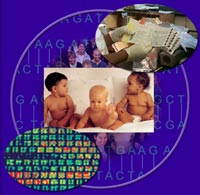Events

Banking Newborn Blood Spots for Public Health
September 23-24, 2002
Atlanta, GA
|
Time |
Beginning Session | Presenter |
|---|---|---|
| 8:30 a.m. | CDC Welcome and Introductions |
Muin Khoury
|
| 8:35 a.m. | Meeting Objectives and Importance of Population-Based Data for Public Health Decision Making |
Mary Lou Lindegren
Richard Olney |
| 8:45 a.m. | Overview of Storage and Use of Newborn Screening Specimens |
Kenneth Pass
|
| 9:00 a.m. | Overview of Uses, Methods, Technology, Challenges of Newborn Blood Spot BioBank, The Danish Example |
Bent Norgaard-Pedersen
|
| 9:30 a.m. | Break | |
| SESSION I. | PUBLIC HEALTH APPLICATIONS AND FUTURE USES AND DIRECTIONS Moderators: Karen Edwards, Washington; Diana Schendel, CDC |
|
| 9:45 a.m. | Uses of Banked DNA Bloodspots to Assess the Genetic Health of New York State |
Michele Caggana
|
| 10:00 a.m. | Massachusetts Model Using HIV Seroprevalence and MCAD as Examples | Anne Comeau |
| 10:15 a.m. | Uses of Linked Spot Bank to Study Markers of Birth Defects and Other Developmental Disabilities |
Gary Shaw/Fred Lorey
|
| 10:30 a.m. | Diabetes Study in Washington State | Michael Glass |
| 10:45 a.m. | MeningococcalStudy |
Jai Lingappa
|
| 11:00 a.m. | Panel and Group Discussion State Health Departments: Public Health Resource Stewards and Research PartnersWhat are potential important public health research issues that could be addressed using population-based stored dried-blood spots?
|
|
| 12:15 noon | Lunch | |
| SESSION II. | TECHNOLOGY ISSUES Moderators: Kenneth Pass, New York; Pam Costa, CDC |
|
| 1:00 p.m. |
Laboratory IssuesDNA based Technology Using Dried Blood Spots |
Michele Caggana
|
| New Applications: Using Dried Blood Spots in Research Studies, QC |
Joanne Mei
|
|
| Storage Issues |
David Boyer
|
|
| 1:30 p.m. | Group Discussion | |
| 1:45 p.m. | Database IssuesData Collected Through NBS |
Brad Therrell
|
| Linkages of Databases |
Pam Costa
|
|
| Cataloguing/Retrieval Systems |
Richard Frome
|
|
| 2:15 p.m. | Group Discussion | |
| SESSION III. | MODEL APPROACHES AND METHODS/STATE ISSUES Moderators: Anne Comeau, Massachusetts; Omar Henderson, CDC |
|
| 2:30 p.m. | Overview of Potential Strawman Models for Discussion Key Elements of Different Alternatives and Strengths and Weaknesses A. Anonymous Banks B. Linked Banks |
|
| 2:45 p.m. | State and Group Discussion State Health Departments: Public Health Resource Stewards and Research Partners State Health Department Comments addressing issues below – CA, GA, MA, MI, MN, NC, NY, RI, SC, TX, WA
|
|
| 3:30 p.m. | Break | |
| 3:45-5:10 p.m. | Continued Group Discussion: Outline Challenges and Barriers and Key Elements of Several Alternatives for Model Anonymous and Linked Banks |
Anne Comeau
|
| 5:05 p.m. | Summarize Discussion | |
| 5:45 p.m. | Van to hotel | |
| Tuesday, Septermber 24, 2002 | ||
| SESSION IV. | SUMMARY FROM DAY ONE Moderators: Fred Lorey, California; Mary Lou Lindegren, CDC |
|
| Overview of issues discussed day one to facilitate discussion of next steps for Strategic Plan (5-10 minutes each) |
||
| 8:30 a.m. | Public Health Application and Uses |
Karen Edwards
|
| Technical Issues |
Roger Eaton
|
|
| Strengths, Weaknesses, Challenges for Anonymous Models |
Mark McCann
|
|
| Strengths, Weaknesses, Challenges for Linked Models |
Paul Fernhoff
|
|
| Feasibility Issues |
Harold Dowda
|
|
| 9:20-10:15 a.m | Group Discussion | |
| 10:15 a.m | Break | |
| SESSION V. | NEXT STEPS FOR STRATEGIC PLAN Moderators: George Cunningham, California, Harry Hannon, CDC |
|
| 10:30 a.m. | Update from on NBS Informed Consent Meeting |
George Cunningham
Michele Puryear |
| 10:45 a.m. | Updating Storage and Retention Policies for Publication |
Richard Olney
|
| 10:10 a.m. |
APHL Update |
Jelili Ojodu
|
| 11:10-1:00 p.m. | Group Discussion of Next Steps for Implementation Steps
Charge: |
|
| 1:15 p.m. | Summarize Next Steps |
Harry Hannon
|
| 1:45 | Adjourn | |